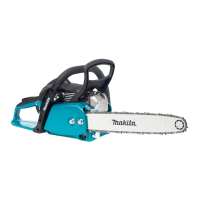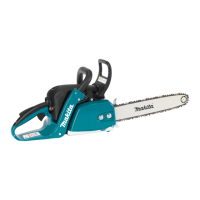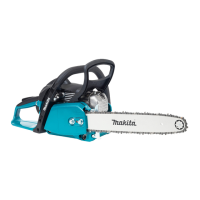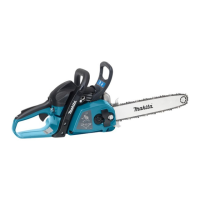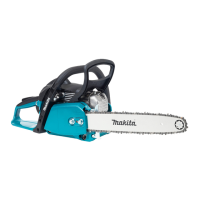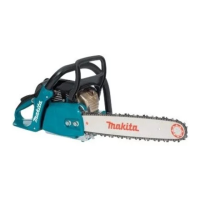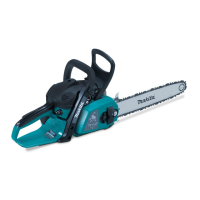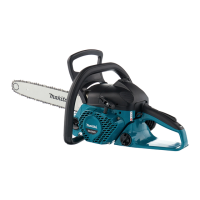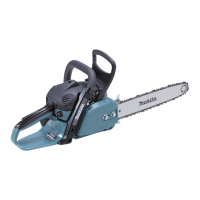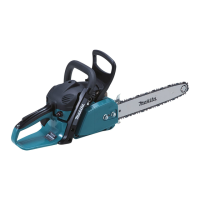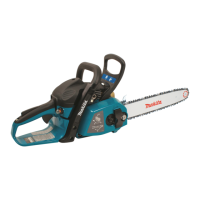Operator’s and Safety Manual
for Gasoline Chain Saws
Manuel d’emploi et de sécurité
de tronçonneuses thermiques
Manual de empleo y de seguridad
para motosierras
WARNING! Read and understand this Manual. Always follow safety precautions in the Operator’s and Safety
Manual. Improper use can cause serious injury! Preserve this Manual carefully!
WARNING! FUELS WITH MORE THAN 10% ETHANOL ARE NOT APPROVED FOR USE IN MAKITA 2-STROKE
ENGINES! Use of alternative fuels, such as E-20 (20% ethanol), E-85 (85% ethanol) or any fuels not meeting MAKITA
requirements are not approved for use in MAKITA 2-stroke gasoline engines!
USE OF ALTERNATIVE FUELS CAN CAUSE THE FOLLOWING PROBLEMS: Poor engine performance, loss of
power, overheating, fuel vapor lock, improper clutch engagement, premature deterioration of fuel lines, premature
deterioration of gaskets, premature deterioration of carburetors. USING ALTERNATIVE FUELS AND/OR 2-STROKE
OILS NOT ACCORDING TO JASO FC OR ISO-L-EGD IN MAKITA 2-STROKE ENGINES WILL VOID YOUR ENGINE
WARRANTY!
AVERTISSEMENT! Suivez toujours les conseils de sécurité du présent manuel d’emploi et de sécurité. Une
utilisation incorrecte de la tronçonneuse peut entraîner des blessures graves! Lisez et comprenez ce manuel.
Conservez avec soin ce manuel!
AVERTISSEMENT! LES CARBURANTS CONTENANT PLUS DE 10 % D’ÉTHANOL NE SONT PAS AUTORISÉS
POUR L’UTILISATION DANS LES MOTEURS 2 TEMPS! Les carburants alternatifs, tels que E-20 (20 % d’éthanol),
E-85 (85 % d’éthanol) ou tout autre carburant n’étant pas conformes aux exigences MAKITA ne sont pas autorisés
pour l’utilisation dans les moteurs essence à 2 temps MAKITA!
L’UTILISATION DE CARBURANTS ALTERNATIFS PEUT CAUSER LES PROBLÈMES SUIVANTS: Faible performance
moteur, Perte de puissance, Surchauffe, Bouchons de vapeur dans la conduite d’essence, Embrayage incorrect,
Détérioration prématurée des conduites d’essence, Détérioration prématurée des joints d’étanchéité, Détérioration
prématurée des carburateurs. L’UTILISATION DE CARBURANTS ALTERNATIFS ET/OU D’HUILES 2 TEMPS NON-
CONFORMES À LA NORME JASO FC OU ISO-L-EGD DANS LES MOTEURS À 2 TEMPS MAKITA ANNULERA VOTRE
GARANTIE MOTEUR!
¡ADVERTENCIA! Observe siempre las instrucciones de seguridad contenidas en el manual. Lea y compenétrese
con el contenido del manual. El uso inadecuado de la motosierra puede causar lesiones de gravedad.
Conserve este manual cuidadosamente.
¡ADVERTENCIA! ¡NO SE AUTORIZAN LOS COMBUSTIBLES CON MÁS DEL 10% DE ETANOL PARA SU USO EN
LOS MOTORES DE 2-TIEMPOS MAKITA! ¡El uso de combustibles alternativos, como el E-20 (20% de etanol), E-85
(85% de etanol) o cualquier otro combustible que no cumplan los requisitos de MAKITA no están autorizados para
su uso en motores de gasolina de 2-tiempos MAKITA!
EL USO DE COMBUSTIBLES ALTERNATIVOS PUEDE CAUSAR LOS SIGUIENTES PROBLEMAS: Pobre rendimiento
del motor, Pérdida del potencia, Sobrecalentamiento, Formación de burbujas de vapor en la tubería del
combustible, Acople inadecuado del embrague, Deterioro prematuro de las tuberías de combustible, Deterioro
prematuro de la juntas, Deterioro prematuro del carburador. EL USO DE COMBUSTIBLES ALTERNATIVOS Y DE
ACEITES PARA MOTORES DE 2-TIEMPOS DISTINTOS DE LOS DE LA NORMA JASO FC O ISO-L-EGD EN EN LOS
MOTORES DE 2-TIEMPOS MAKITA ANULARÁ LA GARANTIA DEL MOTOR.
EA3500S
EA3501S
